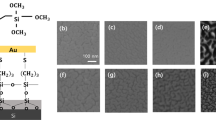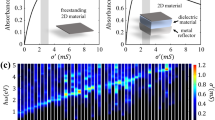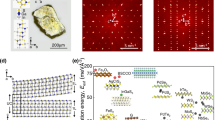Abstract
Broadband and efficient terahertz absorbing films are crucial to high-performance terahertz detectors, which are in demand for next-generation wireless communications, astronomy, security screening, medical imaging and so on. Recent studies reported a series of two-dimensional materials for enhanced light absorption in terahertz waves, such as graphene, transition metal dichalcogenides and topological insulators, among others. However, it is still challenging to achieve the intrinsic thin-film absorption limit (50%) across the whole ultrabroad terahertz band. Here we demonstrate that ultrathin 10.2-nm-thick (~λ/30,000) Ti3C2Tx MXene assemblies can reach the intrinsic thin-film absorption limit across the entire 0.5–10 THz band. Such intriguing phenomena are attributed to the highly concentrated free electrons (~1021 cm−3), short relaxation time (~10 fs) and unique intra- and interflake (hopping) electron transport properties in Ti3C2Tx MXenes. Our results are validated by alternating current impedance theory using the Drude–Smith model, rather than classic direct current impedance matching. We believe that our findings will stimulate more studies of broadband terahertz technologies with MXenes and beyond, providing a route to developing compact, supercontinuum terahertz optoelectronic or photothermoelectric devices.
This is a preview of subscription content, access via your institution
Access options
Access Nature and 54 other Nature Portfolio journals
Get Nature+, our best-value online-access subscription
$29.99 / 30 days
cancel any time
Subscribe to this journal
Receive 12 print issues and online access
$209.00 per year
only $17.42 per issue
Buy this article
- Purchase on Springer Link
- Instant access to full article PDF
Prices may be subject to local taxes which are calculated during checkout



Similar content being viewed by others
Data availability
The experimental dataset and its analysis are provided within the article and its Supplementary Information, and the data are available from the corresponding authors upon reasonable request.
References
Rogalski, A., Kopytko, M. & Martyniuk, P. 2D material infrared and terahertz detectors: status and outlook. Opto-Electron. Rev. 28, 107–154 (2020).
Lin, H. et al. A 90-nm-thick graphene metamaterial for strong and extremely broadband absorption of unpolarized light. Nat. Photon. 13, 270–276 (2019).
Alves, F., Karamitros, A., Grbovic, D., Kearney, B. & Karunasiri, G. Highly absorbing nano-scale metal films for terahertz applications. Opt. Eng. 51, 063801 (2012).
Oda, N. Uncooled bolometer-type terahertz focal plane array and camera for real-time imaging. C. R. Phys. 11, 496–509 (2010).
Pham, P. H. et al. Broadband impedance match to two-dimensional materials in the terahertz domain. Nat. Commun. 8, 2233 (2017).
Yao, B. et al. Broadband gate-tunable terahertz plasmons in graphene heterostructures. Nat. Photon. 12, 22–28 (2018).
Xia, F. et al. Two-dimensional material nanophotonics. Nat. Photon. 8, 899–907 (2014).
Li, D. et al. Ultrafast dynamics of defect-assisted auger process in PdSe2 films: synergistic interaction between defect trapping and auger effect. J. Phys. Chem. Lett. 13, 2757–2764 (2022).
Wu, L. et al. A sudden collapse in the transport lifetime across the topological phase transition in (Bi1−xInx)2Se3. Nat. Phys. 9, 410–414 (2013).
Di Pietro, P. et al. Observation of Dirac plasmons in a topological insulator. Nat. Nanotechnol. 8, 556–560 (2013).
Suo, P. et al. Observation of negative terahertz photoconductivity in large area type-II Dirac semimetal PtTe2. Phys. Rev. Lett. 126, 227402 (2021).
Dai, Z. et al. High mobility 3D Dirac semimetal (Cd3As2) for ultrafast photoactive terahertz photonics. Adv. Funct. Mater. 31, 2011011 (2021).
Chanana, A. et al. Manifestation of kinetic inductance in terahertz plasmon resonances in thin-film Cd3As2. ACS Nano 13, 4091–4100 (2019).
Hadley, L. N. & Dennison, D. Reflection and transmission interference filters part I. Theory. J. Opt. Soc. Am. 37, 451–465 (1947).
Hadley, L. N. & Dennison, D. M. Reflection and transmission interference filters part II. Experimental, comparison with theory, results. J. Opt. Soc. Am. 38, 483–496 (1948).
Hilsum, C. Infrared absorption of thin metal films at non-normal incidence. J. Opt. Soc. Am. 45, 135–136 (1955).
Patterson, J. D., Bailey, B. C. & Harrison, W. Solid-state physics: introduction to the theory. Phys. Today 61, 59 (2008).
Liang, G. et al. Integrated terahertz graphene modulator with 100% modulation depth. ACS Photon. 2, 1559–1566 (2015).
Mics, Z. et al. Thermodynamic picture of ultrafast charge transport in graphene. Nat. Commun. 6, 7655 (2015).
Ghidiu, M., Lukatskaya, M. R., Zhao, M. Q., Gogotsi, Y. & Barsoum, M. W. Conductive two-dimensional titanium carbide ‘clay’ with high volumetric capacitance. Nature 516, 78–81 (2014).
Kamysbayev, V. et al. Covalent surface modifications and superconductivity of two-dimensional metal carbide MXenes. Science 369, 979–983 (2020).
Natu, V. et al. Effect of base/nucleophile treatment on interlayer ion intercalation, surface terminations, and osmotic swelling of Ti3C2Tz MXene multilayers. Chem. Mater. 34, 678–693 (2022).
Mohammadi, A. V., Rosen, J. & Gogotsi, Y. The world of two-dimensional carbides and nitrides (MXenes). Science 372, eabf1581 (2021).
Naguib, M., Mochalin, V. N., Barsoum, M. W. & Gogotsi, Y. 25th anniversary article: MXenes: a new family of two-dimensional materials. Adv. Mater. 26, 992–1005 (2014).
Shahzad, F. et al. Electromagnetic interference shielding with 2D transition metal carbides (MXenes). Science 353, 1137–1140 (2016).
Miranda, A., Halim, J., Barsoum, M. W. & Lorke, A. Electronic properties of freestanding Ti3C2Tx MXene monolayers. Appl. Phys. Lett. 108, 033102 (2016).
Li, G. J. et al. Equilibrium and non-equilibrium free carrier dynamics in 2D Ti3C2Tx MXenes: THz spectroscopy study. 2D Mater. 5, 035043 (2018).
Li, S. J., Xu, S. J., Pan, K. C., Du, J. & Qiu, J. Ultra-thin broadband terahertz absorption and electromagnetic shielding properties of MXene/rGO composite film. Carbon 194, 127–139 (2022).
Lin, Z. H. et al. Highly stable 3D Ti3C2Tx MXene-based foam architectures toward high-performance terahertz radiation shielding. ACS Nano 14, 2109–2117 (2020).
Shui, W. et al. Ti3C2Tx MXene sponge composite as broadband terahertz absorber. Adv. Opt. Mater. 8, 2001120 (2020).
Xiao, X., Wang, H., Urbankowski, P. & Gogotsi, Y. Topochemical synthesis of 2D materials. Chem. Soc. Rev. 47, 8744–8765 (2018).
Karpowicz, N. et al. Coherent heterodyne time-domain spectrometry covering the entire ‘terahertz gap’. Appl. Phys. Lett. 92, 011131 (2008).
Cocker, T. L. et al. Microscopic origin of the Drude-Smith model. Phys. Rev. B 96, 205439 (2017).
Zheng, W. H. et al. Band transport by large Frohlich polarons in MXenes. Nat. Phys. 18, 544–550 (2022).
Slobodkin, Y. et al. Massively degenerate coherent perfect absorber for arbitrary wavefronts. Science 377, 995–998 (2022).
Acknowledgements
This work is supported by the National Key Research and Development Program of China (grant numbers 2017YFA0701000 and 2020YFA0714001), the Natural Science Foundation of China (grant numbers 61988102, 61921002, 62071108 and 62235004), the Outstanding Scholarship Foundation of UESTC (grant number A1098531023601243), the Sichuan Science and Technology Support Program (grant number 2021JDTD0026), the Natural Science Foundation of Sichuan Province (grant numbers 2022NSFSC0513, 2022NSFSC0514, 2023NSFC0437 and 2023NSFSC0437), the Fundamental Research Funds for the Central Universities (grant numbers ZYGX2020ZB007 and ZYGX2020J003), the fund of Key Laboratory of THz Technology, Ministry of Education, China, the Science and Engineering Research Council of A*STAR (Agency for Science, Technology and Research) Singapore (grant number M22L1b0110) and the NRF, Prime Minister’s Office, Singapore, under the Competitive Research Program Award (grant number NRF-CRP26-2021-0063). We thank W. Xie, S. Ding and L. Cheng for fruitful discussions.
Author information
Authors and Affiliations
Contributions
X.X. and C.-W.Q. supervised the work. T.Z., P.X., H.W. and T.D. fabricated the samples and performed the measurements. E.L., X.C. and T.W. performed the air plasma-based THz-TDS measurements. T.Z., P.X., H.W., T.D., C.-W.Q. and X.X. analysed the data with the help of J.X., Q.Z., Y.W., Y.G., Q.W. and M.H. T.Z., M.L., C.-W.Q. and X.X. wrote the paper with input from all co-authors.
Corresponding authors
Ethics declarations
Competing interests
The authors declare no competing interests.
Peer review
Peer review information
Nature Photonics thanks the anonymous reviewers for their contribution to the peer review of this work.
Additional information
Publisher’s note Springer Nature remains neutral with regard to jurisdictional claims in published maps and institutional affiliations.
Supplementary information
Supplementary Information
Supplementary Figs. 1–24, Tables 1–3, Methods and References.
Rights and permissions
Springer Nature or its licensor (e.g. a society or other partner) holds exclusive rights to this article under a publishing agreement with the author(s) or other rightsholder(s); author self-archiving of the accepted manuscript version of this article is solely governed by the terms of such publishing agreement and applicable law.
About this article
Cite this article
Zhao, T., Xie, P., Wan, H. et al. Ultrathin MXene assemblies approach the intrinsic absorption limit in the 0.5–10 THz band. Nat. Photon. 17, 622–628 (2023). https://doi.org/10.1038/s41566-023-01197-x
Received:
Accepted:
Published:
Issue Date:
DOI: https://doi.org/10.1038/s41566-023-01197-x
This article is cited by
-
Organohydrogel-based transparent terahertz absorber via ionic conduction loss
Nature Communications (2024)
-
MXenes for multispectral electromagnetic shielding
Nature Reviews Electrical Engineering (2024)
-
Stretchable, Transparent, and Ultra-Broadband Terahertz Shielding Thin Films Based on Wrinkled MXene Architectures
Nano-Micro Letters (2024)
-
When MXenes meet terahertz radiation
Nature Photonics (2023)
-
Diverse Structural Design Strategies of MXene-Based Macrostructure for High-Performance Electromagnetic Interference Shielding
Nano-Micro Letters (2023)



